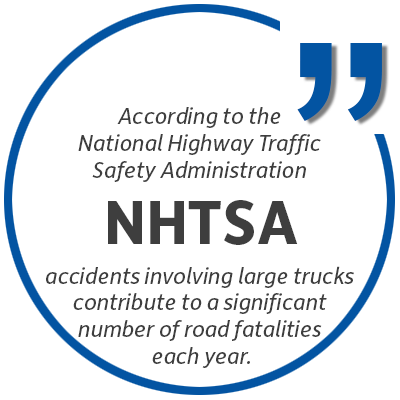Semi trucks are a common sight on our roads and highways, with truck drivers playing a crucial role in transporting goods across the country. However, the massive semi truck vehicles come with their own set of challenges, one of the most significant being blind spots.
Understanding the blind spot of a semi truck is essential for all road users to provide safety and prevent blind spot truck accidents. In this article, we will delve into the details of semi truck blind spots, their dangers, and how both truck drivers and other car drivers can avoid accidents.
What Are Semi Truck Blind Spots?
To begin, let’s explore what a truck’s blind spots are and what significant blind spots semi truck drivers need to know about.
Definition of Semi Truck Blind Spots
Semi truck blind spots, also known as “no zones,” are the areas around commercial trucks, triple trailers, 18 wheeler vehicles, or other trucks of massive size where the driver has limited or no visibility. These spots can hide other vehicles, pedestrians, and cyclists, creating dangerous situations on the road. Unlike passenger vehicles, semi trucks have significantly larger blind spots due to their size and design.
Locations of Blind Spots on a Semi Truck
Front Blind Spots
The front blind spot is the area directly in front of the truck’s cab. Due to the height of the cab, truck drivers cannot see anything in this no zone, which can extend up to 20 feet in front of the truck. The truck’s mirrors don’t angle forward, so they are unable to help prevent a truck driver’s failure to observe a smaller vehicle or other obstruction in front of them.
Side Blind Spots
The side blind spots, particularly on the right side of the truck, are the most extensive no zones. The passenger side, or right side blind spot, can extend up two lanes to even three lanes wide. Truck drivers can use side view mirrors to limit the range of the spot, but there are still areas that will be hard to see in order to safely change lanes and avoid liability. Keeping a careful eye out for other vehicles and using your side windows as well as side mirrors will help professionals in the trucking industry avoid collisions.
The left side also has a no zone, although it is smaller than the right side. Navigating into the left lane is easier for truck drivers, but still presents risks. The side mirror gives a better view of any other vehicle in the two lanes or less to the left side, but road safety still presents guidelines for every trucking company to avoid liability and check these left side no zones.
Rear Blind Spots
The rear blind spot is located directly behind the truck’s trailer. This area is particularly dangerous, as the truck driver has no rearview mirror to see behind the trailer. The size and location of the truck’s cab makes rearview mirrors impractical and not helpful for navigating larger blind spots.
This lack of rearview mirrors and even tools like backup cameras makes it difficult for drivers of massive vehicles to detect vehicles following too closely. To avoid tailgating, a good rule is to put a sign on the back of the trailer so passenger vehicles know about the limited view.
Trailer Blind Spots
The trailer itself creates additional blind spots for truck drivers, especially during turns. This no zone can obscure smaller vehicles and lead to collisions and even an underride collision if other drivers are not paying attention. While most drivers know to avoid trucks that are changing lanes or making wide turns, not everyone is aware of the range of a truck driver’s blind spot.
Why Are Semi Truck Blind Spots Dangerous?

Increased Risk of Accidents for Truck Drivers
Blind spots significantly increase the risk of accidents. According to the National Highway Traffic Safety Administration (NHTSA), accidents involving large trucks contribute to a significant number of road fatalities each year. The sheer size and weight of semi trucks mean that collisions often result in severe injuries or fatalities for the occupants of smaller vehicles and passenger vehicles.
Common Types of Accidents Involving Blind Spots from Semi Trucks
Sideswipe Accidents

Sideswipe accidents occur when a truck changes lanes and collides with a vehicle the truck driver cannot see.
These truck accidents are common on highways, where lane changes are frequent and other vehicles aren’t always paying attention.
Rear-End Collisions
Rear-end collisions happen when a vehicle follows too closely behind a truck and the truck driver makes a sudden stop. The rear blind spot makes it difficult for the truck driver to see vehicles directly behind them. Drivers in passenger vehicles need to avoid distractions and closely follow road safety laws in order to avoid these truck accidents.
Right Turn Accidents
Right turn accidents occur when a truck makes a wide right turn and collides with a vehicle or pedestrian on the right side of the truck’s trailer. These accidents are particularly dangerous in urban areas with heavy pedestrian traffic and can occur when a truck driver fails to check the truck’s mirrors and avoid the blind spot accident.
How to Avoid a Blind Spot Truck Accident
Staying Visible
One of the most important safety measures is to stay visible to the truck driver. Avoid lingering in the truck’s blind spots and ensure that you can see the truck driver’s mirrors. If you can see the driver, they can see you. Remember that a truck’s cab is much higher, and be aware of where the no zone is located.
Passing Safely
When overtaking a semi truck, do so quickly and on the left side whenever possible. Avoid cutting in too closely in front of trucks after passing and check the side mirror to see that you’ve passed ahead of large trucks before merging.
Maintaining a Safe Following Distance
Maintain a safe following distance, especially behind a truck. This gives you ample time to react if the truck stops suddenly and helps avoid rear-end collisions. Your vehicle can be almost impossible to see without a rearview mirror, so to avoid blind spot accidents, give truck drivers plenty of space.
Tips for Cyclists and Pedestrians
Awareness and Caution
Cyclists and pedestrians should be especially cautious around semi trucks. Avoid riding or walking in the truck’s blind spots, particularly near intersections. A semi truck accident involving a cyclist or pedestrian can be fatal, so use caution and seek compensation or a free consultation from a personal injury attorney if you have been injured by a truck accident.
Using Crosswalks and Bike Lanes Safely
Always use designated crosswalks and bike lanes. Be extra vigilant when a truck is turning or changing lanes to avoid a potentially fatal truck accident. If your own road safety behavior is left unchanged, your risk of a serious accident can increase. While determining negligence is multi-layered, doing the most you can to protect yourself can help reduce damages and injuries.
Technology and Solutions to Reduce a Blind Spot Truck Accident
New technologies and solutions to address these accidents are helping reduce the number and severity of truck accidents to keep pedestrians, passengers, and small vehicle drivers safe.
Blind Spot Detection Systems
Detection systems use sensors and cameras to alert the truck driver of vehicles in their blind spots. These systems have been shown to significantly reduce the risk of blind spot accidents by shrinking the no zone and giving drivers more awareness. Advanced Driver Assistance Systems (ADAS) are known to be reliable.
Cameras and Sensors
Modern trucks are increasingly equipped with cameras and sensors that provide real-time visibility around the truck. These technologies help mitigate the risks associated with blind spots and reduce truck accidents that may have occurred if the truck design was left unchanged.
Driver Training and Education
Proper training for truck drivers is crucial in reducing blind spot accidents. Many programs focus on teaching drivers to be more aware of their blind spots and how to check them effectively. These programs teach drivers to use their side mirror, check on the left side, and practice road safety to avoid a blind spot accident.
Legal Aspects of Semi Truck Blind Spot Accidents
If you have been the victim of a truck accident, you may be able to seek compensation for your damages, such as medical bills or insurance premiums.
Liability in Blind Spot Accidents
Determining liability in accidents can be complex. It often involves assessing the truck driver’s actions, the behavior of other drivers, vehicle safety compliance, and potential negligence from trucking companies.
Seeking Compensation After an Accident
If you are involved in a blind spot accident, it is essential to seek legal advice. A truck accident attorney can help you navigate the process of seeking compensation for medical bills, vehicle damage, lost wages, and other damages.
Frequently Asked Questions about Semi Truck Blind Spots
- What should I do if I find myself in a semi truck’s blind spot? Move out of the spot as quickly and safely as possible.
- How can I tell if I am in a semi truck’s blind spot? If you cannot see the truck driver in their side mirrors, you are likely in their blind spot.
- Are there specific times of day when blind spots are more dangerous? Blind spots are always dangerous, but visibility can be reduced during nighttime or poor weather conditions.
- Do all trucks have the same blind spots? While the locations of blind spots are generally similar, their size can vary depending on the truck’s design and length.
- What new technologies are being developed to address blind spot issues? Innovations such as enhanced camera systems, radar, and advanced driver assistance systems are continually being developed to improve blind spot visibility.
Contact Crossen Law Firm Today
Awareness of semi truck blind spots is crucial for all road users. By understanding where these blind spots are and how to avoid them, we can significantly reduce the risk of accidents.
Safety on the road is a shared responsibility. Whether you are a truck driver or driving a passenger vehicle, staying vigilant and practicing safe driving habits can make a difference. If you ever find yourself in a blind spot accident, seeking legal help from a reliable and empathetic truck accident attorney can ensure you receive the support and compensation you deserve.
Meet our team of dedicated professionals who bring not only their legal expertise but also a genuine commitment to helping each client.
If you have any further questions or need legal assistance, don’t hesitate to reach out to Crossen Law Firm at 317-401-8626 for a free consultation.

 317-401-8626
317-401-8626 
.jpg)